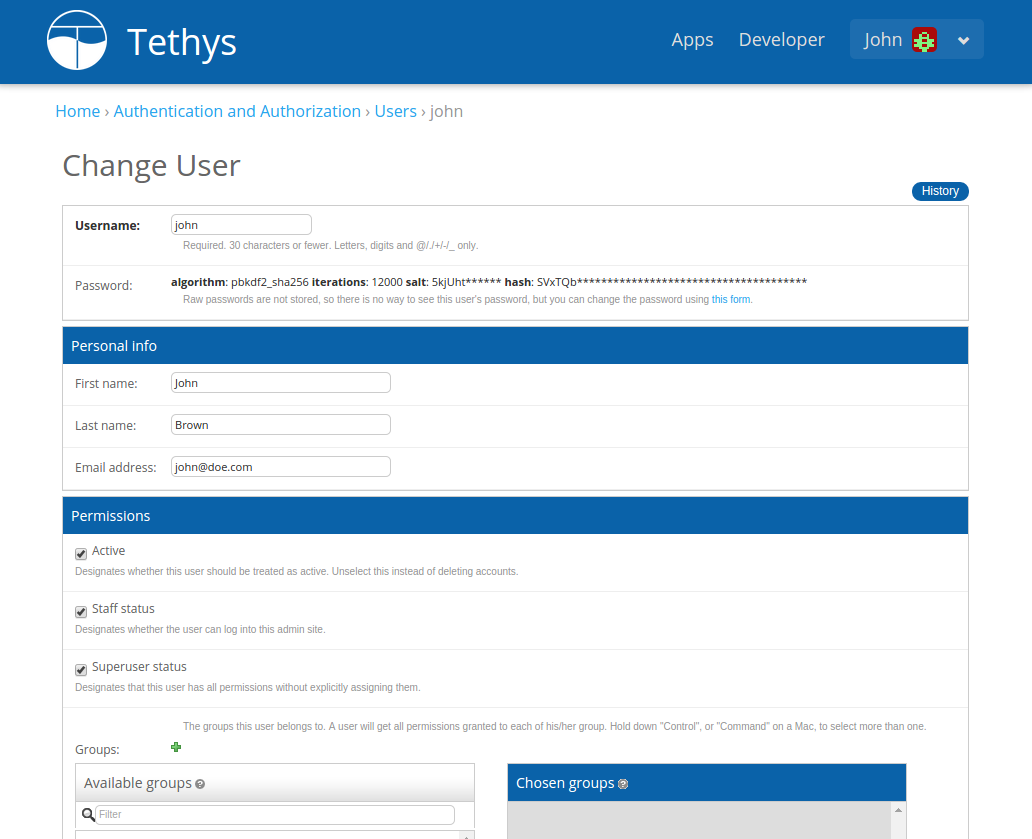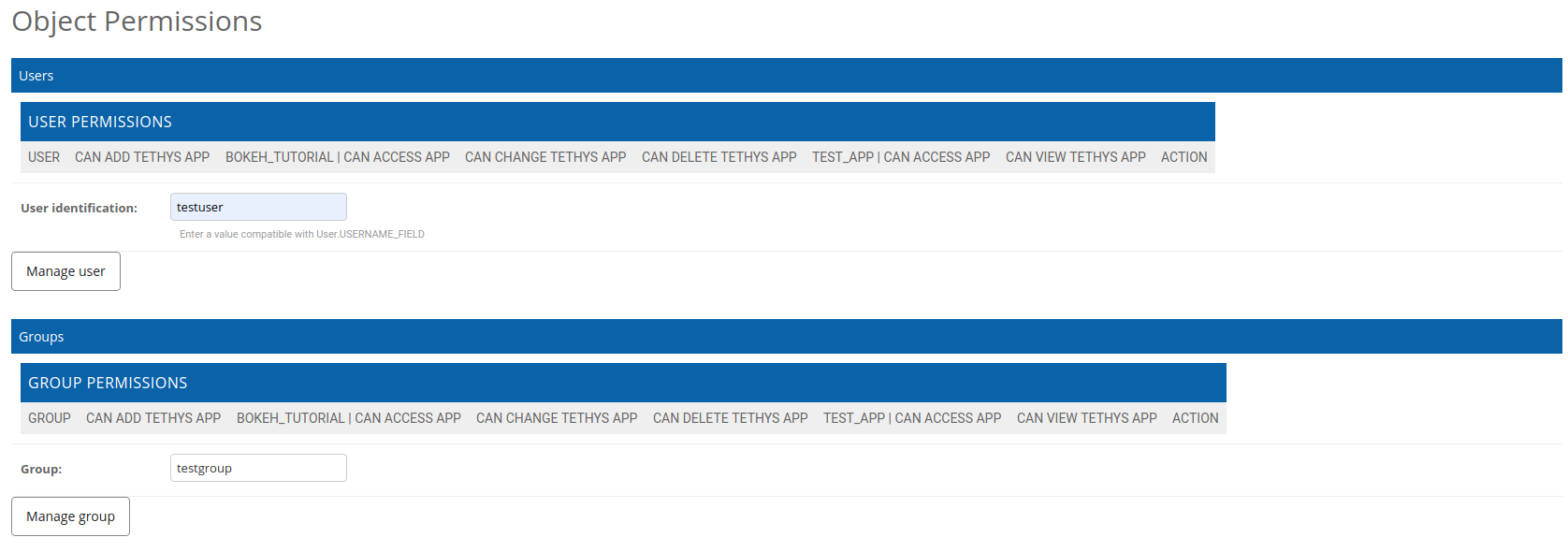Administrator Pages
Last Updated: May 2023
Tethys Portal includes administration pages that can be used to manage the website (see Figure 1). The administration dashboard is only available to administrator users (staff users). You should have created a default administrator user when you installed Tethys Platform. If you are logged in as an administrator, you will be able to access the administrator dashboard by selecting the "Site Admin" option from the user drop down menu in the top right-hand corner of the page (when you are not in an app).

Figure 1. Administrator dashboard for Tethys Portal.
Note
If you did not create an administrator user during installation, run the following command in the terminal:
tethys manage createsuperuser
Auth Token
Important
This feature requires the djangorestframework library to be installed. Starting with Tethys 5.0 or if you are using micro-tethys-platform, you will need to install djangorestframework using conda or pip as follows:
# conda: conda-forge channel strongly recommended
conda install -c conda-forge djangorestframework
# pip
pip install djangorestframework
Tethys REST API tokens for individual users can be managed using the Tokens link under the AUTH TOKEN heading (see Figure 2).
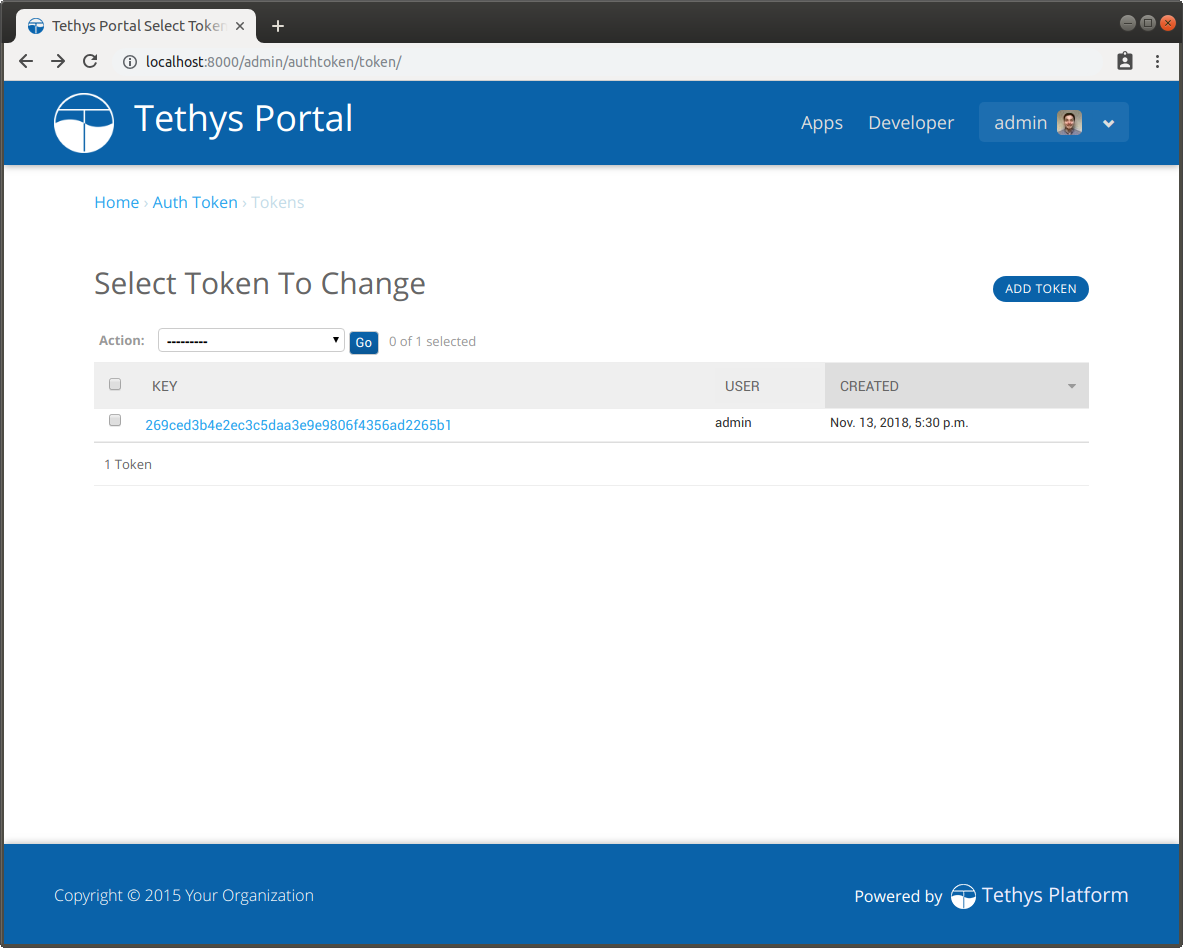
Figure 2. Auth Token management page for Tethys Portal.
Terms and Conditions
Important
This feature requires the django-termsandconditions library to be installed. Starting with Tethys 5.0 or if you are using micro-tethys-platform, you will need to install django-termsandconditions using conda or pip as follows:
# conda: conda-forge channel strongly recommended
conda install -c conda-forge django-termsandconditions
# pip
pip install django-termsandconditions
Portal administrators can manage and enforce portal wide terms and conditions and other legal documents via the administrator pages.
Use the Terms and Conditions link to create new legal documents (see Figure 9). To issue an update to a particular document, create a new entry with the same slug (e.g. 'site-terms'), but a different version number (e.g.: 1.10). This allows you to track multiple versions of the legal document and which users have accepted each. The document will not become active until the Date active field has been set and the date has past.
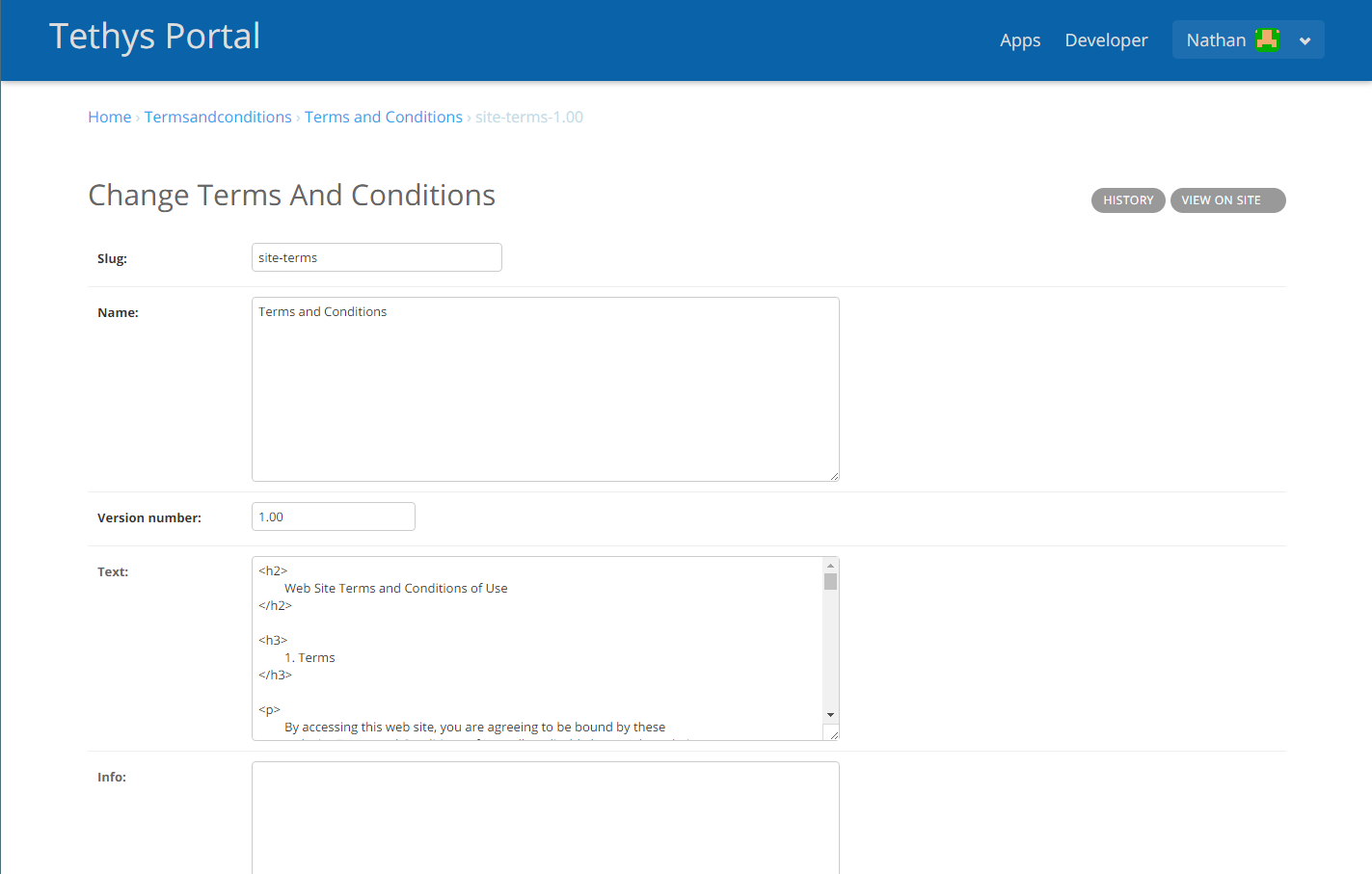
Figure 9. Creating a new legal document using the terms and conditions feature.
When a new document becomes active, users will be presented with a modal prompting them to review and accept the new terms and conditions (see Figure 10). The modal can be dismissed, but will reappear each time a page is refreshed until the user accepts the new versions of the legal documents. The User Terms and Conditions link shows a record of which users have accepted the terms and conditions.

Figure 10. Terms and conditions modal.
Tethys Apps
The links under the TETHYS APPS heading can be used to manage settings for installed apps and extensions and proxy apps.
Installed Apps and Extensions
Clicking on the Installed Apps or Installed Extensions links will show a list of installed apps or extensions. Clicking on a link for an installed app or extension will bring you to the settings page for that app or extension. There are several different types of app settings: Common Settings, Custom Settings, and Service Settings.
An app can be disabled by unchecking the Enabled checkbox in the app settings page. A 404 error will be displayed in place of the disabled app if a user tries to open the app. Disabled apps appear as transparent apps in the Apps Library to admin users and users with permissions to access the app. Other users will not see the app in the Apps Library.
An app can also be hidden from the Apps Library by unchecking the Show in apps library checkbox. Hidden apps can still be accessed directly through their URL endpoints by Admin users and users with app access permissions. In addition, Admin users can still see the app in the Apps Library, but the app icon appears transparent and with the hidden tag added to the app title. Users without permission to access the app cannot see the app in the Apps Library or access it directly through its URL endpoint.
The order that the apps appear in the Apps Library (alphabetically by default) can be controlled using the Order setting on the app settings page. The apps will be displayed in assending order.
Common Settings
The Common Settings include those settings that are common to all apps or extension such as the Name, Description, Icon, Color, Tags, Order, Enabled, Show in apps library, and Enable feedback (see Figure 11). Many of these settings correspond with attributes of the term:app class and can be overridden by the portal administrator. Others control the sorting order, visibility, or accessibility of the app. A brief description of the common settings is provided below:
Name: The name of the app that will appear on the app tile on the Apps Library page (e.g.: "My First App").
Description: A description of the app that will be displayed when the user clicks on the info icon on the app tile.
Icon: Override the icon/logo of the app with a different icon. Accepts a relative path to a static file (e.g.:
my-first-app/images/other-logo.png) or a URL to an externally hosted image (e.g.:https://some.other-site.org/static/other-logo.png).Color: Override the theme color of the app (e.g.:
#1A2B3C).Tags: One or more tags for an app. Wrap each tag in double quotes and separate by commas (e.g.:
"Hydrology","Grided Data","THREDDS").Enabled: Enable or disable the app. Disabled apps are not accessible to non-admin users.
Show in apps library: Display the app on the Apps Library page. The app is still accessible by URL, but no app tile will be shown in the apps library.
Order: Force the order that apps are listed on the Apps Library page. Default order is alphabetical.
Enable feedback: When on, a button that launches a feedback form added to every page of the app. The feedback will be emailed to users listed in the
feedback_emailssetting in theapp.py.

Figure 11. App settings page showing Common Settings.
Custom Settings
Custom Settings appear under the CUSTOM SETTINGS heading and are defined by the app developer (see Figure 12). Most Custom Settings have simple values such as strings, integers, floats, or booleans, but all are entered as text. For boolean type Custom Settings, type a valid boolean value such as True or False.
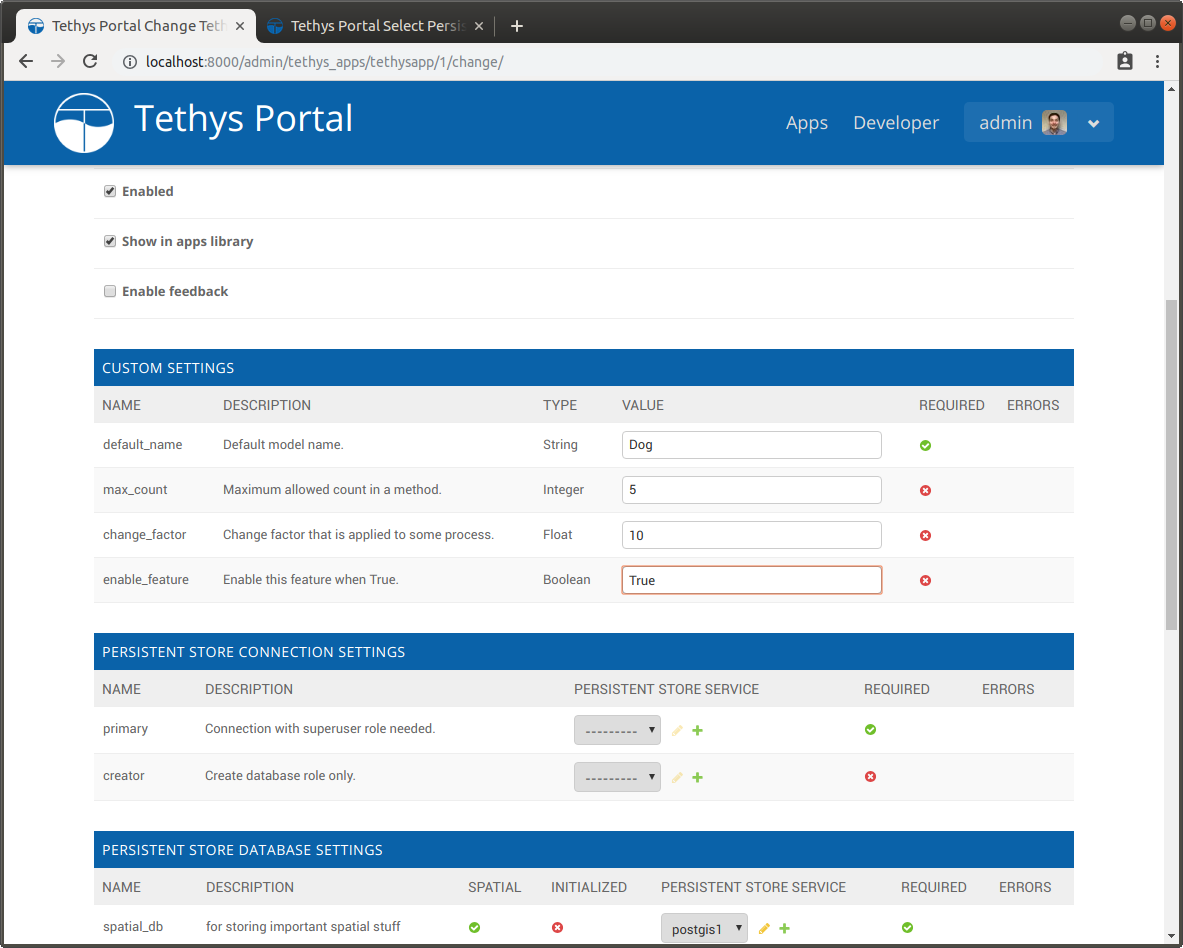
Figure 12. Custom Settings section of an app.
Secret Custom Settings
Secret Custom Settings can be used to store sensitive information that is need by your app such as passwords and API keys. The values of Secret Custom Settings are encrypted before being stored in the database and not displayed on the settings page for additional security. Secret Custom Setting values are returned as strings when you access them in your app.

Figure 13. Secret Custom Settings section of an app.
JSON Custom Settings
Important
This feature requires the django-json-widget library to be installed. Starting with Tethys 5.0 or if you are using micro-tethys-platform, you will need to install django-json-widget using conda or pip as follows:
# conda: conda-forge channel strongly recommended
conda install -c conda-forge django-json-widget
# pip
pip install django-json-widget
Don't Forget: If you end up using this feature in your app, add django-json-widget as a requirement to your install.yml.
JSON Custom Settings store JSON strings and provide an embedded JSON editor on the settings page for easy editing. In addition, you may initialize a JSON Custom Setting with a JSON file when installing an app.

Figure 14. JSON Custom Settings section of an app.
Service Settings
There are several different types of Service Settings including: Persistent Store Connection Settings, Persistent Store Database Settings, Dataset Service Settings, Spatial Dataset Service Settings, and Web Processing Service Settings (see Figure 15). These settings specify the types of services that the apps require. Use the drop down next to each Service Setting to assign a pre-registered Tethys Service to that app or use the plus button to create a new one.
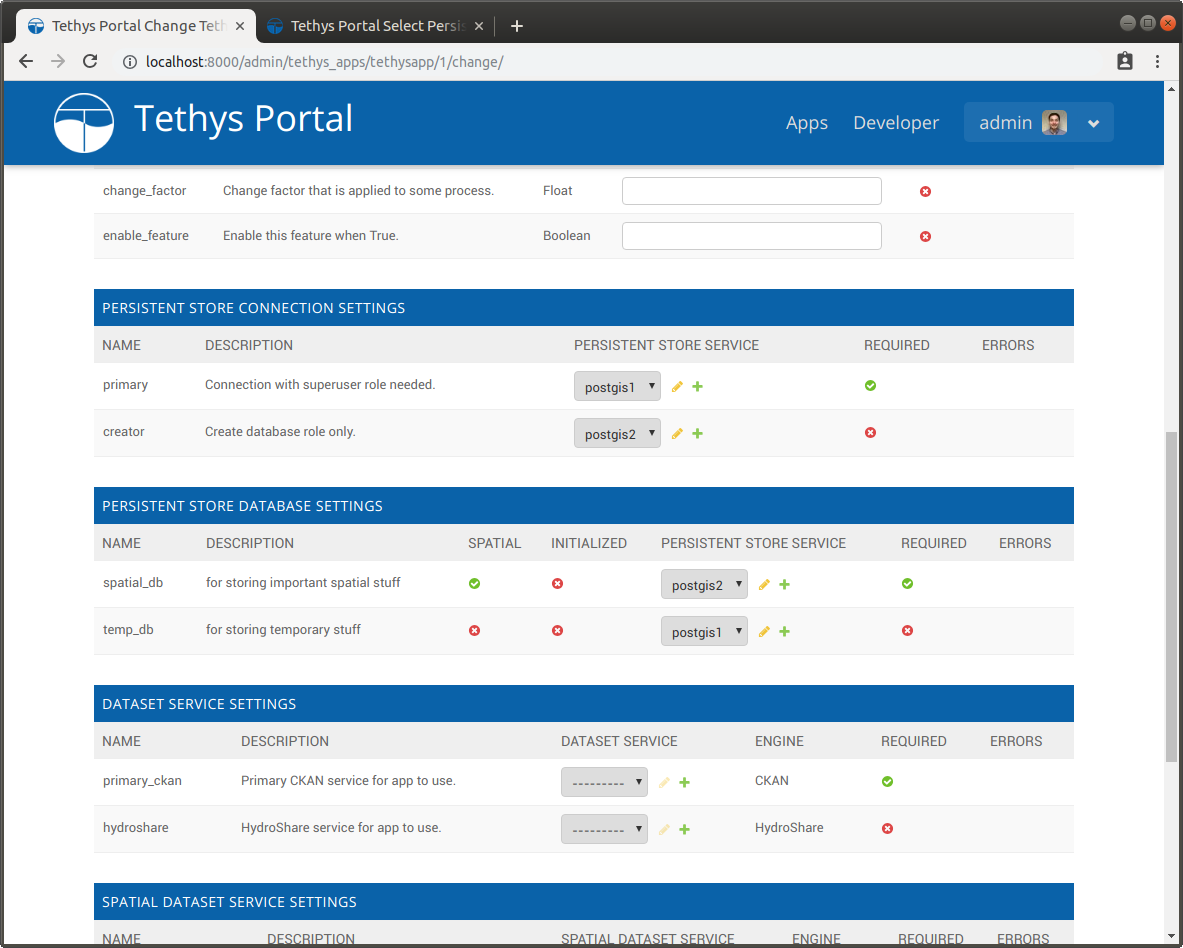
Figure 15. Service Settings sections of an app.
Tip
For information on how to define settings for your app see the App Settings API documentation. See Tethys Services for how to configure different Tethys Services.
Proxy Apps
Proxy apps are links to external web applications or websites. They are represented in the App Library page with an app tile just like native Tethys Apps. To manage the Proxy Apps in a Tethys Portal, click on the Proxy Apps link under the TETHYS APPS heading. Click on the ADD PROXY APP button to create a new Proxy App. Proxy Apps have many of the same configuration options as normal Tethys Apps including Name, Description, Tags, Enabled, Show in apps library and Order, but there are a few options that are specific to Proxy apps (see Figure 16). A brief description of each option is provided below:
Name: The name of the app that will appear on the app tile on the Apps Library page (e.g.: "My Proxy App").
Endpoint: The URL that will be opened when the user clicks on the app tile of the proxy app (e.g.:
https://my.proxy.app/foo/).Logo url: The URL of the image that will be displayed on the app tile of the Proxy App (e.g.:
https://my.proxy.app/static/foo-logo.org).Back url: A URL to suggest as the back URL; usually points to the referring portal. If the Proxy App is a Tethys App on another Tethys Portal (>4.0.0), the Exit button for the app will be set to this URL (e.g.:
https://this.portal.org/apps/).Description: A description of the app that will be displayed when the user clicks on the info icon on the app tile.
Tags: One or more tags for an app. Wrap each tag in double quotes and separate by commas (e.g.:
"Hydrology","Grided Data","THREDDS").Enabled: Enable or disable the app. Disabled apps are not accessible to non-admin users.
Show in apps library: Display the app on the Apps Library page. The app is still accessible by URL, but no app tile will be shown in the apps library.
Open in new tab: Open the proxy app link in a new tab or window when on. Open it the same tab or window when off.
Order: Force the order that apps are listed on the Apps Library page. Default order is alphabetical.
Display External Icon: By default, this feature is turned off. When enabled, it adds an icon to the app tile to distinguish the proxy app from regular apps, indicating that it is an external link.

Figure 16. The Add Proxy App dialog.
Tethys Compute
The links under the TETHYS COMPUTE heading can be used to manage Jobs and Schedulers:
Tip
For more information on Tethys Jobs see the Jobs API documentation.
Tethys Portal
The links under the TETHYS PORTAL heading can be used to customize the look of the Tethys Portal. For example, you can change the name, logo, and color theme of the portal (see Figure 17).
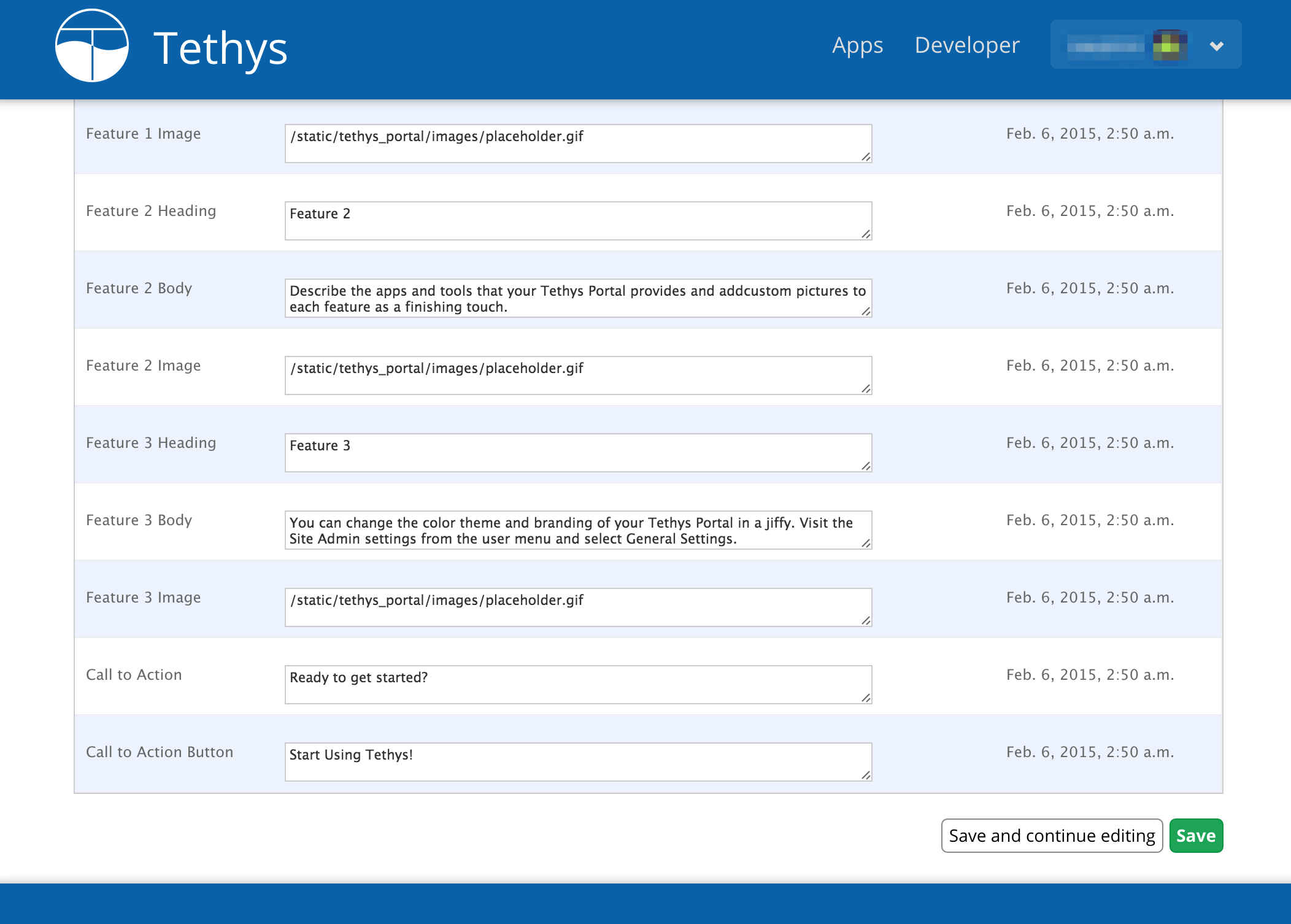
Figure 17. Home page settings for Tethys Portal.
Tip
For more information on customizing the Tethys Portal see the Customize Portal Theme (Recommended) documentation, and the Site Settings documentation.
Tethys Quotas
The link under the TETHYS QUOTAS heading can be used to manage resource quotas that have been loaded into the Tethys Portal. Custom quotas can be created (see Creating Custom Quotas), but by default Tethys includes two quotas: User Workspace Quotas and App Workspace Quotas.
Resource Quotas
Resource Quotas shows a list of all loaded quotas. By default, all quotas are disabled when they are first loaded. Use this page to enable and customize the quotas for your portal (see Figure 18).
All quotas have the following fields that can be customized:
Default- Default quota value.Help- Help text to be displayed to users when a quota is exceeded.Active- Enable to enforce this quota.Impose default- When enabled the default quota will be used for users/apps that do not have a specific quota set. When disabled the quota will not be enforced on users/apps that do not have a specific quota set.
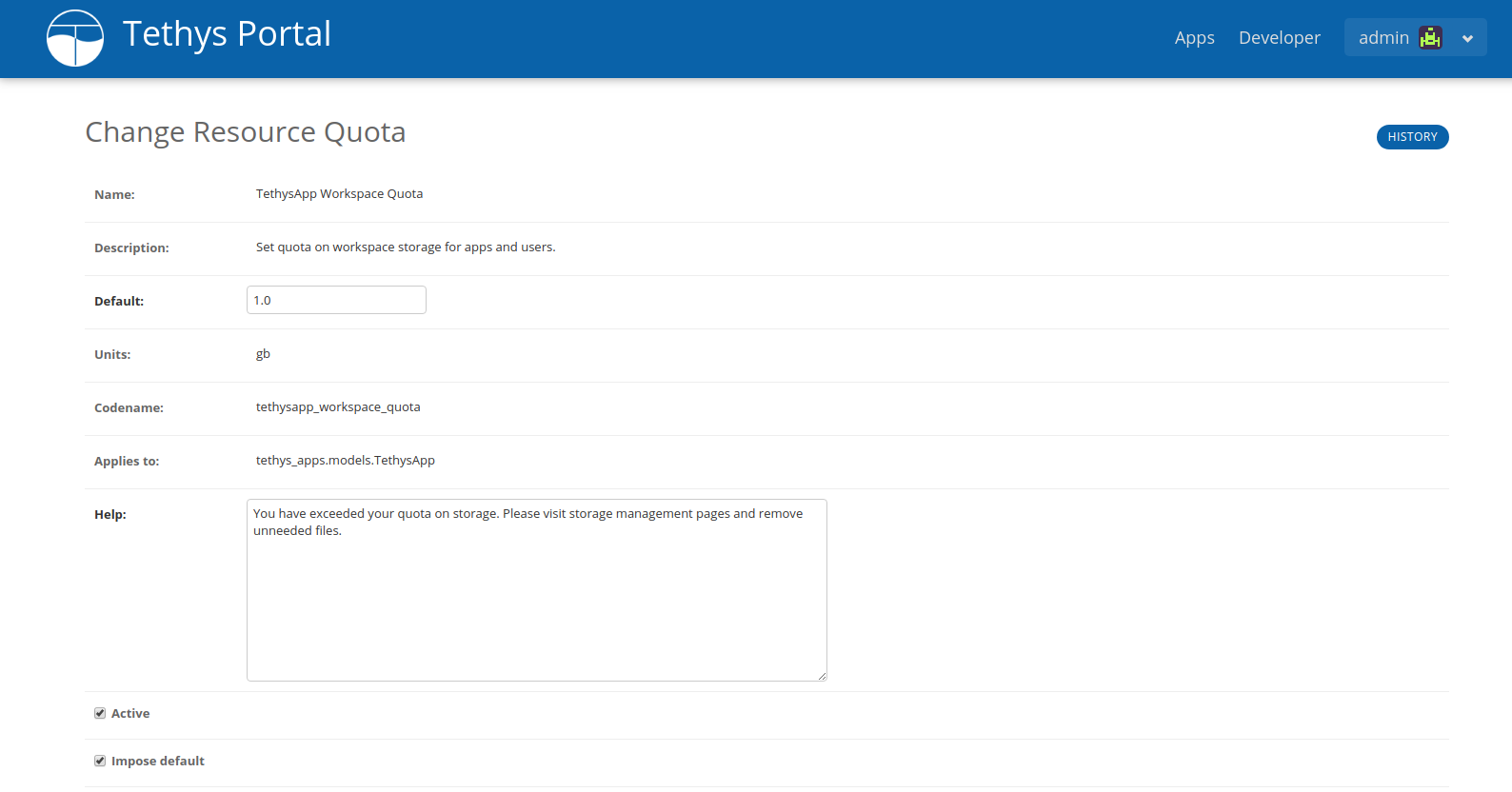
Figure 18. Resource Quota settings page.
User Workspace Quotas
To manage quotas specific to individual users, navigate to the user's settings page. Any applicable Resource Quotas will be listed in the User Quotas section. To set a custom quota for the user, enter the custom value in the Value field on the line corresponding to the appropriate Resource Quota. A link to the Resource Quota is also provided in the table (see Figure 19).
Tip
See Manage User Storage for details on how to manage user workspace storage.

Figure 19. User settings page showing User Quotas.
App Workspace Quotas
To manage quotas specific to individual apps, navigate to the specified app's settings page. Any applicable Resource Quotas will be listed in the Tethys App Quotas section. To set a custom quota for the app, enter the custom value in the Value field on the line corresponding to the appropriate Resource Quota. A link to the Resource Quota is also provided in the table (see Figure 20).
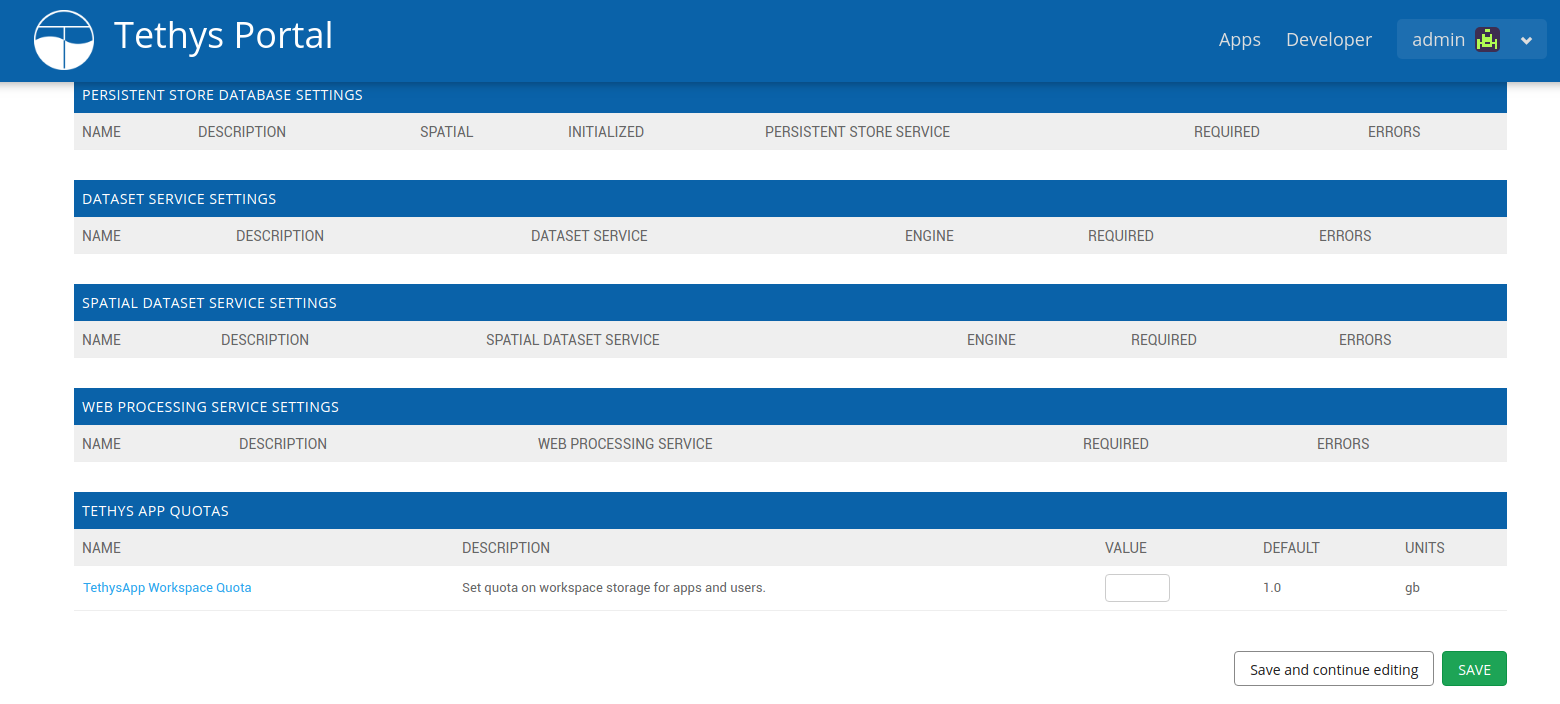
Figure 20. App settings page showing Tethys App Quotas.
Manage App Storage
Within the app settings page there is a Manage app storage section that provides a summary of the app workspace storage and the current quota being enforced on it (see Figure 11). To clear the workspace click the Clear Workspace button.
Warning
Clear Workspace will completely empty the app workspace.
Tip
See Handling Workspace Clearing for information on how to pre/post process the app workspace when it is cleared.
Tethys Services
The links under the TETHYS SERVICES heading can be used to register external services with Tethys Platform for use by apps and extensions. Use the Spatial Dataset Services link to register your Tethys Portal to GeoServer, the Dataset Services link to register to CKAN or HydroShare instances, the Web Processing Services link to register to WPS instances, or the Persistent Store Services link to register a database.
Tip
For detailed instructions on how to use each of these services in apps, refer to these docs:
